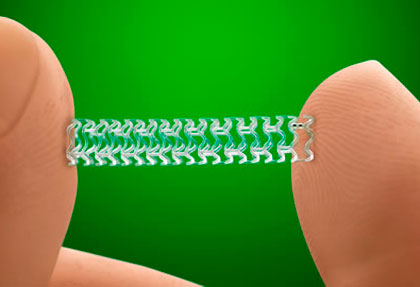Coronary angioplasty with drug-eluting stents (DES) is associated with a 2-3% annual incidence of stent-related events, a risk that has not significantly decreased despite improvements in device technology. Bioresorbable vascular scaffolds (BVS) were designed to address this issue through several mechanisms: complete device resorption would free the epicardial vessel, thus restoring vasomotor function, and would facilitate the release of side branches jailed by the stent.

The most extensively studied device is the ABSORB BVS (Abbott Vascular), which is fully bioresorbed in vivo within approximately three years. However, several randomized studies comparing BVS with DES (everolimus-eluting stents, EES) observed a higher risk of adverse events within the first three years due to factors such as relatively thick struts, limited expansion range, recoil, and suboptimal implantation techniques.
The aim of this meta-analysis was to assess the long-term outcomes of BVS compared to DES over a five-year follow-up period. The primary endpoint (PE) was target-lesion failure (TLF), defined as a composite of cardiac death, target-vessel myocardial infarction (TV-MI), or ischemia-driven target-lesion revascularization (ID-TLR). The safety endpoint was device thrombosis.
Read also: Is Angioplasty Always Necessary after TAVR?
The study included a total of 5988 patients, with 3457 randomized to the BVS group and 2531 to the DES group. Between years 0 and 5, TLF occurred in 15.9% of all BVS patients compared to 13.1% of all DES patients (hazard ratio [HR]: 1.25; 95% confidence interval [CI]: 1.08-1.43; P = 0.002), while device thrombosis occurred in 2.2% versus 1.0% of patients, respectively (HR: 2.38; 95% CI: 1.49-3.79; P = 0.0002). Between years 0 and 3, TLF was 12.4% with BVS compared to 9.3% with DES (HR: 1.35; 95% CI: 1.15-1.59; P = 0.0002), and device thrombosis occurred in 2.0% versus 0.6% of subjects, respectively (HR: 3.58; 95% CI: 2.01-6.36; P < 0.0001). At 5 years, the rate for TLF was in 4.5% of BVS patients compared to 4.7% with DES (HR: 0.99; 95% CI: 0.76-1.27; P = 0.91), and device thrombosis occurred in 0.2% versus 0.4% of cases, respectively (HR: 0.49; 95% CI: 0.18-1.38; P = 0.17).
Conclusion
In this meta-analysis of five randomized trials comparing everolimus-eluting Absorb BVS to cobalt-chromium Xience EES (Abbott Vascular) in 5988 patients, the rates of adverse ischemic events were higher with first-generation BVS during the first three years. However, the period of highest risk matched the time required for complete device resorption. After it, event rates were similar between BVS and EES, with a low incidence of device thrombosis between years 3 and 5. BVS could be a viable alternative for coronary angioplasty if device design is optimized and implantation techniques are improved.
Original Title: Early and Late Outcomes With the Absorb Bioresorbable Vascular Scaffold Final Report From the ABSORB Clinical Trial Program.
Reference: David A. Power, MD et al JACC Cardiovasc Interv.2025;18:1–11.
Subscribe to our weekly newsletter
Get the latest scientific articles on interventional cardiology





